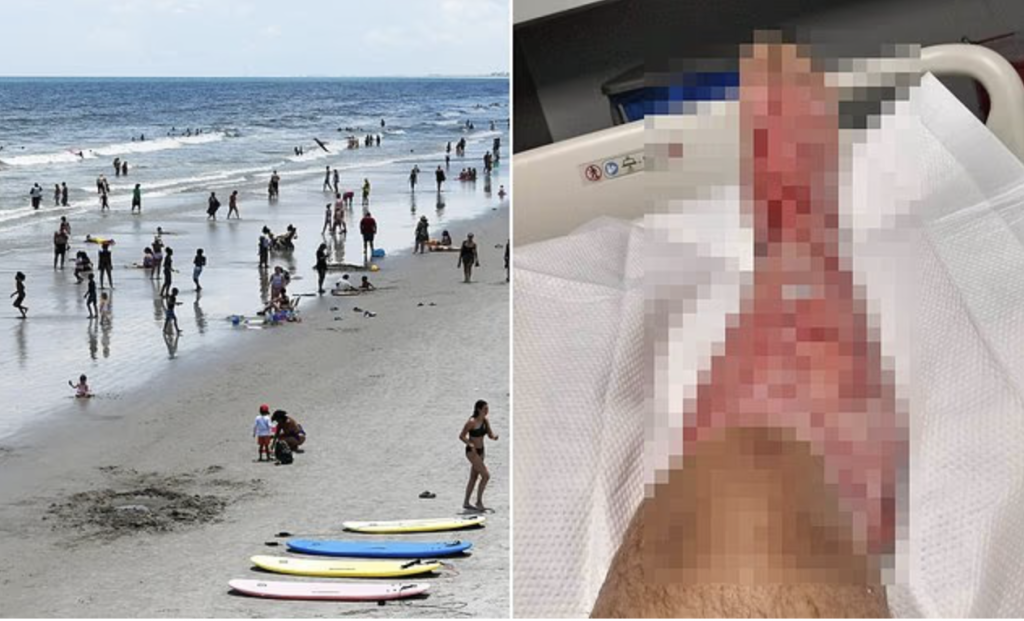
The threat posed by flesh-eating bacteria lurking on beaches and in rivers this summer is looming larger by the week, as cases climb into the double digits and deaths are following suit.
Vibrio vulnificus eats away at tissues in the skin until they shrivel, turn black, and die, a condition called necrotizing fasciitis, requiring lengthy surgery to strip the dead skin from the patient’s body or amputation to remove the limb to save the person’s life.
The bacteria typically populates the waters off the Gulf Coast, but has slowly made its way northward, appearing in the waters off North Carolina, where it has infected 59 people and killed one since January 1, according to state health records.
Florida, meanwhile, has reported 16 cases this year and a death toll of five. And Louisiana health officials have reported 17 cases of Vibrio vulnificus so far this year, four of which have proven fatal.
Deadly bacteria living in coastal and brackish waters (a mix of fresh and salt water) can infect swimmers through open wounds or strike unsuspecting diners who eat raw or undercooked seafood like oysters.
Health experts warn the bug can cause everything from nasty bouts of stomach illness to dangerous wound infections and, in the most severe cases, it can trigger life-threatening blood poisoning.
The bacteria’s steady rise is, experts believe, a consequence of warming waters. The bacteria thrive in waters between 68 degrees Fahrenheit and 95 degrees Fahrenheit (20 degrees Celsius to 35 degrees Celsius).
These temperatures are becoming more common as the planet warms, and as ocean temperatures rise, Vibrio is spreading further north and remaining on coasts longer.
Worsening storms and flooding are also washing the bacteria into freshwater, putting swimmers and seafood lovers at higher risk.
While Florida’s tally thus far falls short of the annual average of 48 cases and 11 deaths, in Louisiana, the state’s averages for both have been dwarfed by the current figures.
There have been 17 cases so far this year, including four deaths. By comparison, an average of seven V. vulnificus cases and one death have been reported each year in Louisiana over the previous 10 years.
All 17 patients have been hospitalized, according to the Louisiana Department of Health.
Texas saw an average number of Vibrio cases of about 33 per year from 2015 to 2019, the latest year available. Annually, cases have fluctuated between 22 to 36.
In 2019 in Texas, Adam Perez, 42, was hospitalized and lost most of the flesh on the lower half of his right leg after a dangerous dip in Waters Edge Park in Corpus Christi.
He had to undergo four different life-saving surgeries, including skin grafts over his leg.
The threat posed by flesh-eating bacteria lurking on beaches and in rivers this summer is looming larger by the week, as cases climb into the double digits and deaths are following suit.
Vibrio vulnificus eats away at tissues in the skin until they shrivel, turn black, and die, a condition called necrotizing fasciitis, requiring lengthy surgery to strip the dead skin from the patient’s body or amputation to remove the limb to save the person’s life.
The bacteria typically populates the waters off the Gulf Coast, but has slowly made its way northward, appearing in the waters off North Carolina, where it has infected 59 people and killed one since January 1, according to state health records.
Florida, meanwhile, has reported 16 cases this year and a death toll of five. And Louisiana health officials have reported 17 cases of Vibrio vulnificus so far this year, four of which have proven fatal.
Deadly bacteria living in coastal and brackish waters (a mix of fresh and salt water) can infect swimmers through open wounds or strike unsuspecting diners who eat raw or undercooked seafood like oysters.
Health experts warn the bug can cause everything from nasty bouts of stomach illness to dangerous wound infections and, in the most severe cases, it can trigger life-threatening blood poisoning.
The bacteria’s steady rise is, experts believe, a consequence of warming waters. The bacteria thrive in waters between 68 degrees Fahrenheit and 95 degrees Fahrenheit (20 degrees Celsius to 35 degrees Celsius).
These temperatures are becoming more common as the planet warms, and as ocean temperatures rise, Vibrio is spreading further north and remaining on coasts longer.

+5
View gallery
V. vulnificus thrives in warm coastal waters, such as Florida Gulf Coast beaches. In Florida, 16 people have been infected and five have died
TRENDING


